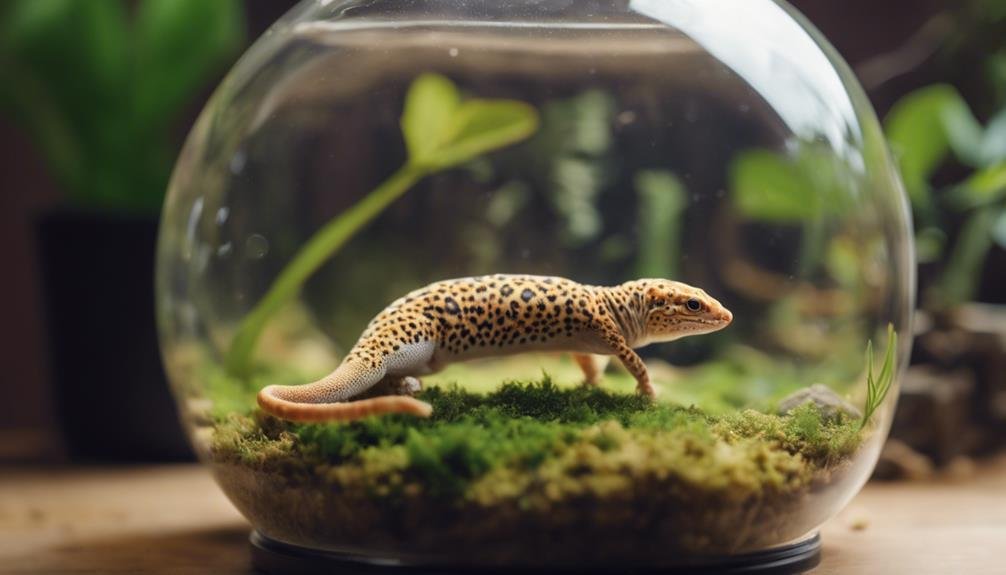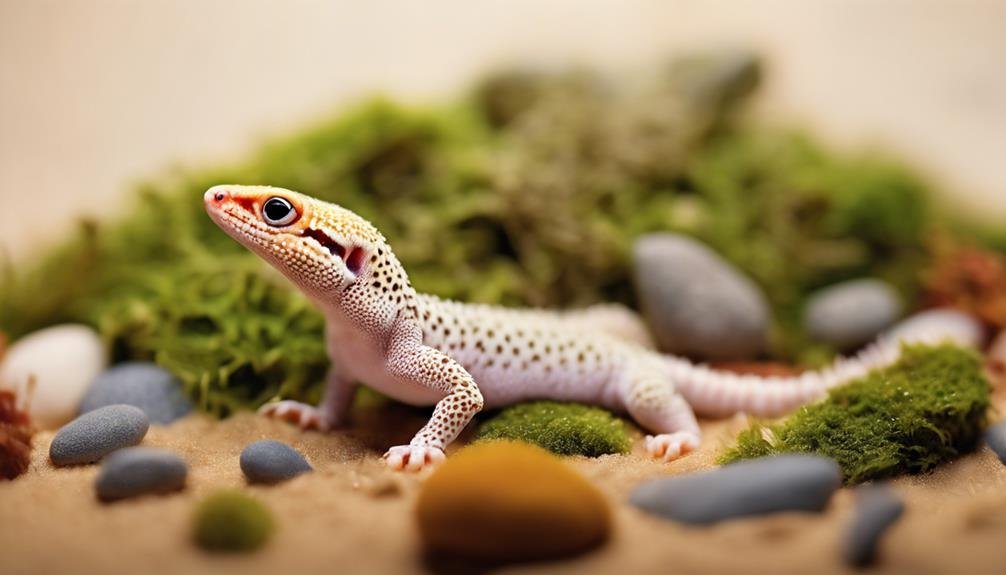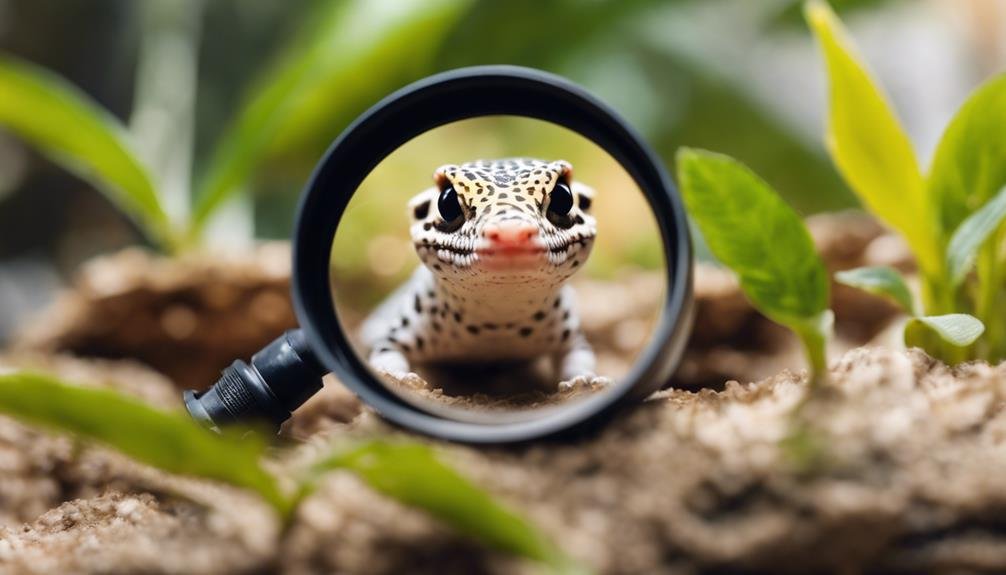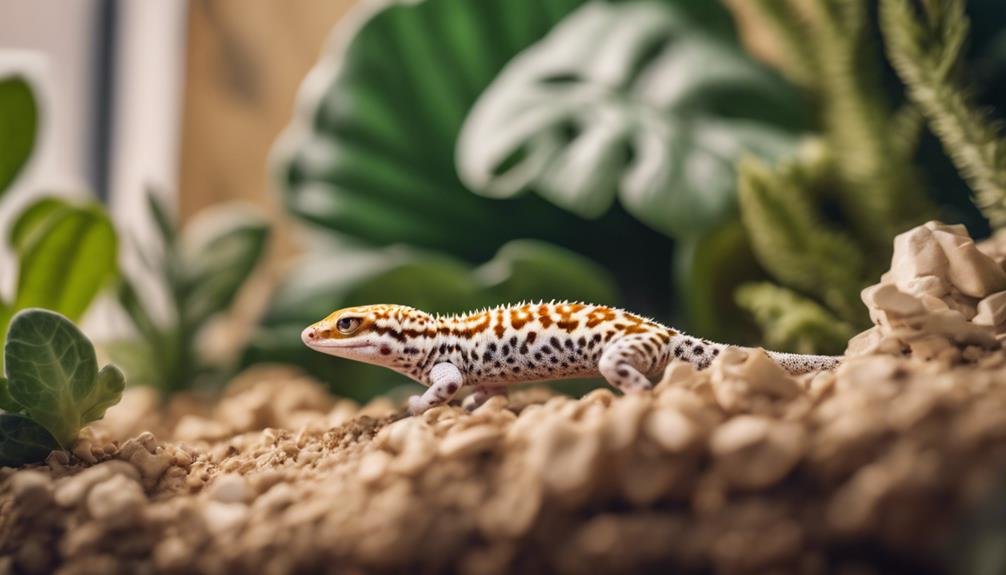If you're considering Eco Earth as a substrate for your Leopard Gecko, you're on the path to mimicking their natural environment, which is essential for their well-being. However, while it offers benefits like humidity control and encourages natural behaviors, you can't overlook the potential risks, such as impaction. Balancing these factors requires a nuanced understanding of their habitat needs and how Eco Earth fits into that picture. Are you ready to weigh the pros and cons to guarantee the health and happiness of your pet? Let's explore what makes a substrate suitable or unsuitable for these fascinating creatures.
Key Takeaways
- Eco Earth mimics a leopard gecko's natural habitat, promoting their physical and mental health.
- It helps manage humidity levels, essential for leopard geckos' well-being.
- Encourages natural digging behaviors, reducing stress and enhancing their environment.
- Low risk of impaction when used correctly, supporting digestive health.
- Can be mixed with other substrates for a customized habitat, offering versatility in tank setup.
Understanding Eco Earth
To properly care for your leopard gecko, it's vital to understand what Eco Earth is and how it can be used effectively in their habitat. Eco Earth is a type of loose substrate that's considered suitable for leopard geckos, provided the tank conditions are meticulously maintained. This substrate can be mixed with sand and soil to create a more tailored environment for your pet, but it's important to keep an eye on the balance to make sure it remains a safe and enriching ground for them to live on.
One of the reasons Eco Earth is favored among leopard gecko enthusiasts is its capacity to help reduce the risks of impaction—a condition where indigestible material can block the digestive tract. Given that leopard geckos might lick surfaces to explore their surroundings, the risk of accidentally ingesting substrate is real. However, with Eco Earth, if the tank conditions such as temperature and humidity are kept ideal, and the gecko is provided with a proper diet, then the ingested Eco Earth should pass through their system without causing harm. This makes it a potentially safer choice of substrate, helping you keep impaction risks at bay.
Natural Habitat Replication
When you're aiming to create a slice of the desert for your leopard gecko, Eco Earth plays an important role in mimicking those arid conditions they thrive in.
It's not just about the look; managing humidity levels becomes vital to mirror their natural environment accurately and guarantee they're not just surviving but flourishing.
Additionally, allowing for safe digging behaviors with Eco Earth encourages your gecko to engage in instinctual activities, supporting both their physical and mental health.
Mimicking Desert Environments
Replicating the natural desert habitats of leopard geckos enhances their well-being by providing a substrate that mirrors their original environment. Desert environments, essential for the well-being of leopard geckos, typically consist of sandy or rocky substrates.
To create a more authentic home for your gecko, consider these options:
- Sand-based Mixes: Ideal for simulating the desert floor, ensuring it's specific for reptiles to avoid ingestion risks.
- Clay and Soil Blends: These can mimic the compact, desert earth, offering a more natural texture and feel.
- Avoiding Eco Earth: Due to its high humidity properties, it's not the best choice for replicating desert environments, which require a drier substrate.
Importance of Humidity Control
Maintaining the appropriate humidity levels is essential for mirroring the natural habitat of leopard geckos and ensuring their health and well-being. Proper humidity control isn't just a box to tick; it's crucial for your gecko to shed properly. Without it, they can struggle, leading to health issues like dehydration and problematic shedding.
For egg-laying females, the right humidity levels are crucial to create the perfect conditions for their eggs. That's where a localized humid hide comes into play. Providing this small, moisture-rich environment allows your gecko to regulate its moisture levels effectively. It's a simple addition to their habitat that makes a world of difference, ensuring they stay healthy and happy in their environment.
Safe Digging Behaviors Encouraged
Eco Earth not only mimics the natural habitat of leopard geckos but also encourages their innate need to dig and burrow, enhancing their overall well-being. This substrate is pivotal in promoting safe digging behaviors, allowing your leopard gecko to exhibit its instinctual actions without any harm. Here's why this matters:
- Promotes Natural Behaviors: By enabling your gecko to dig and burrow, Eco Earth ensures they can express their natural instincts comfortably.
- Reduces Stress: Safe digging opportunities can greatly lower stress levels, contributing to a happier, healthier gecko.
- Increases Mental Stimulation: Engaging in these behaviors keeps your leopard gecko mentally stimulated, which is vital for their overall enrichment and satisfaction.
Choosing Eco Earth as a substrate means you're providing a space that mirrors their wild environment, fostering safe digging behaviors essential for their well-being.
Risks of Impaction
One significant risk leopard geckos face with loose substrates like Eco Earth is impaction, which can cause severe health problems or even death. When your gecko's exploring or hunting, they might accidentally ingest bits of substrate. This can lead to blockages in their digestive system, a condition known as impaction. It's a serious concern, as it can be fatal if not treated promptly.
| Risk Factor | Cause | Prevention |
|---|---|---|
| Ingestion | Hunting/Exploring | Offer food in bowls |
| Loose Substrates | Eco Earth | Use non-ingestible substrates |
| Blockages | Ingested substrate | Regular health checks |
| Health Issues | Impaction | Immediate veterinary care |
Monitoring Humidity Levels


To guarantee your leopard gecko's health, you'll need to closely monitor the enclosure's humidity levels, ideally keeping them between 20% to 40%. Achieving this ideal range is crucial to prevent respiratory issues and dehydration, common concerns for these resilient yet sensitive creatures.
Here are three key steps to make sure you're effectively monitoring and managing the humidity levels for your leopard gecko:
- Invest in a Digital Hygrometer: This tool is your best friend when it comes to accurately measuring humidity levels within the enclosure. Analog hygrometers can be less reliable, so opting for a digital version ensures you get precise readings.
- Create a Humid Hide: Use moistened Eco Earth to create a humid hide within the enclosure. This not only helps in regulating humidity levels but also provides your gecko with a sanctuary to properly hydrate and shed its skin.
- Monitor for Sudden Changes: Keep an eye out for any rapid spikes or drops in humidity levels. Sudden changes can stress your leopard gecko, negatively affecting its health. Regular checks throughout the day can help you maintain a stable environment.
Importance of Proper Temperature
In ensuring your leopard gecko's habitat is as comfortable and health-promoting as possible, you can't overlook the importance of proper temperature. You'll need to master temperature regulation techniques to create an ideal range that mimics their natural environment.
This guarantees your gecko can effectively manage its body temperature, essential for its digestion, metabolism, and overall activity levels.
Temperature Regulation Techniques
Maintaining the right temperature is key to keeping your leopard gecko healthy and happy. Leopard geckos need a specific range of temperatures to thrive and do so through a process known as thermoregulation. This involves moving between warmer and cooler areas within their environment to regulate their body temperature. Here's how you can help:
- Create a Temperature Gradient: Establish a warm basking spot around 88-92°F and guarantee the cool side remains between 70-75°F.
- Use Heat Mats: Place heat mats under the tank to provide a consistent heat source, enabling your gecko to thermoregulate effectively.
- Monitor Temperatures Regularly: Keeping an eye on the temperature guarantees your gecko's environment remains within the ideal range, preventing stress and health issues.
Ideal Temperature Range
Understanding the specific temperature range leopard geckos require is key to their health and well-being. These creatures need a temperature gradient in their habitat, with a warm side between 88-92°F and a cool side of 70-75°F.
This range isn't just for comfort; it's critical for their digestion and metabolism. Without the right temperature gradient, they can't regulate their body temperature effectively, leading to serious health issues. Respiratory infections, poor digestion, and stress are just a few problems that arise from incorrect temperatures.
That's why you've got to use reliable thermometers and heating elements, like ceramic heat emitters or heat mats, to maintain this ideal range. Proper temperature control isn't just about avoiding health issues; it supports their overall activity levels and breeding success in captivity.
Alternatives to Eco Earth


For leopard geckos, Duck Brand Shelf Liner, sand mats, reptile carpet, paper towels, and tiles offer viable alternatives to Eco Earth. Each of these substrates has its unique benefits and drawbacks, allowing you to tailor your pet's habitat to their needs and your maintenance preferences.
When considering alternatives, here are three key points to keep in mind:
- Ease of Cleaning: Paper towels stand out for their hassle-free maintenance. Unlike Eco Earth, which requires careful monitoring to prevent mold and bacteria, paper towels can be quickly replaced, ensuring a clean environment for your leopard gecko.
- Safety: The Duck Brand Shelf Liner and tiles present safer options as they eliminate the risk of ingestion and impaction, issues commonly associated with sand mats. Additionally, tiles offer a durable and aesthetically pleasing option that mimics the natural rocky terrain leopard geckos thrive in.
- Health Risks: While reptile carpet might seem like a good choice, it's important to be aware of its potential to cause injuries. Toes and mouths can get caught in the fibers, leading to unnecessary stress and harm to your pet.
Cleaning and Maintenance
Efficiently cleaning Eco Earth is essential for your leopard gecko's health, involving simple steps like spot cleaning and regular substrate replacement. By using a plastic fork, you can easily sift through the substrate to remove waste, keeping the environment clean and odor-free. This method of cleaning not only makes maintenance straightforward but also guarantees your gecko's habitat remains hygienic.
Regular spot cleaning is a vital part of substrate maintenance, helping to prevent the build-up of waste and unwanted smells. It's a simple yet effective way to maintain a clean living space for your leopard gecko. Additionally, sifting through Eco Earth to remove debris and waste further contributes to creating a healthy environment for your pet.
Replacing soiled substrate on a regular basis is essential to avoid bacterial growth and maintain a healthy habitat. Not only does this practice keep the enclosure clean, but it also safeguards the well-being of your leopard gecko by preventing potential health issues.
Maintaining proper humidity levels within the enclosure can greatly ease the cleaning and maintenance of Eco Earth. Proper humidity helps prevent the substrate from becoming too dry or too moist, making your cleaning routine more effective and straightforward. Maintaining these levels contributes significantly to the overall cleanliness and healthiness of your pet's habitat.
Health Considerations


When considering Eco Earth as a substrate for your leopard gecko, it's crucial to weigh the health implications, including digestion and impaction risks. Eco Earth, being a natural coconut fiber substrate, offers an environment that mimics a gecko's natural habitat. However, the health of your gecko hinges on several important considerations.
Here are three key health considerations to keep in mind:
- Digestive System Safety: Ingested Eco Earth can pass harmlessly through your gecko's digestive system, provided the diet and temperature within the enclosure are correctly maintained. This reduces the concern over accidental ingestion during feeding or exploration.
- Impaction Risks: The risk of impaction, a serious condition where ingested substrate blocks the digestive tract, is low with Eco Earth under the right conditions. Ensuring proper tank temperature and humidity levels are critical to minimizing this risk.
- Dust and Inhalation Concerns: Eco Earth can become dusty, potentially leading to respiratory issues if not properly managed. Moistening the substrate can help reduce dust, thereby safeguarding your gecko's respiratory health.
Can Eco Earth also be used as a substrate for Crested Geckos, or do they need a different type of bedding?
Yes, Eco Earth can definitely be used as a substrate for Crested Geckos. It provides a natural and comfortable bedding for them. However, it’s crucial to also provide crested gecko UVB lighting to ensure they receive the necessary UVB rays for their overall health and well-being.
Frequently Asked Questions
What Is the Best Substrate for Leopard Geckos?
You're likely wondering what the best substrate for your leopard gecko is, considering heat regulation, dust concerns, and allergy risks.
While some keepers swear by sand-based mixes, others find a natural organic mix or quality, sterilized soil from a garden center to be superior.
It's important to choose an option that minimizes dust and allergy risks while ensuring proper heat regulation.
Leo Life substrate has been mentioned as a great alternative.
What Bedding Should I Use for a Leopard Gecko Tank?
For your leopard gecko tank, you should aim for bedding that provides temperature control, enhances tank decoration, and minimizes health risks.
Sand-based mixes with clay and soil, especially when combined with a natural, organic mix and a clean-up crew, offer a superior choice. Avoid products that don't guarantee safety or proper environmental conditions.
Instead, consider high-quality, sterilized garden soil or Leo Life substrate as healthier, more aesthetically pleasing alternatives.
What Is the Best Moist Hide Substrate for Leopard Geckos?
The best moist hide substrate for your leopard gecko is sphagnum moss, thanks to its excellent moisture retention.
You'll want to place it inside the hide to maintain a humid microclimate, essential for shedding and hydration.
Sphagnum moss is also safe if ingested, providing a cozy spot without health risks.
Remember to keep it moist by misting regularly and replace it often to avoid mold and make sure your gecko's hide stays clean and comfortable.
What Is the Bioactive Substrate Mix for Leopard Geckos?
For your leopard gecko, a bioactive substrate mix includes soil, sand, clay, leaf litter, and beneficial microorganisms. This blend promotes a natural environment, allowing your gecko to thrive.
The microfauna play an essential role in organic decomposition, turning waste into nutrients. This setup also aids in temperature control, ensuring your pet's home stays comfortable.
Conclusion
In summary, Eco Earth can be a great choice for your Leopard Gecko, mimicking their natural environment and supporting their well-being. However, you've got to stay vigilant about impaction risks and maintain the right humidity and temperature.
Alternatives exist if Eco Earth doesn't fit your needs. Remember, regular cleaning and keen observation of your pet's health are vital.
By keeping these points in mind, you'll guarantee a happy, healthy habitat for your Leopard Gecko.


